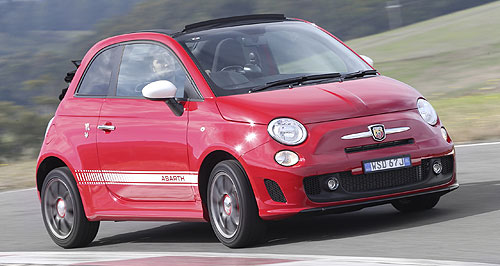Driven: Abarth 595 lands from $27,500
BY DANIEL DEGASPERI | 6th May 2016

Priced from $27,500 plus on-road costs, the 104kW 595 significantly reduces the previous $12,000 gap between the Fiat 500 on which it is based and the former entry to the Abarth range, the $34,000 118kW 595 Turismo.
Speaking at the national media launch of the 595 in Hobart, Tasmania, Fiat Chrysler Automobiles (FCA) Australia senior manager of product planning and strategy Alan Swanson said the balance of sporty styling and a lower pricetag should help the Abarth range grow.
“It’s a big opportunity for us because it’s going to make the Abarth range a lot more accessible,” he said.
“A lot of our customers who shop for the Fiat 500 come into our dealerships and they’re automatically drawn towards the Abarth products. But in the past there has been a large price gap between the 500 range and the Abarth products (so) with this car we’ve cut that price gap in half.”Asked whether he expects the 595 to become the most popular Abarth model in a range that includes 595 Turismo, 595 Competizione and 695 Biposto, Mr Swanson replied: “I think so, purely from the price point, it’s expected to be (the most popular).
“From an age perspective, just from that more attainability, we’re going to take a much younger age group in this vehicle.
“Certainly the previous Abarth range was quite niche, it was priced up there in the mid-thirties, it was very much a novelty to have a vehicle like that.
(Customers) tended to have that as just a second car or weekend car and have quite an expensive, premium car as their everyday car.
“The opportunity we’ve got with this car is that it brings it more towards mainstream vehicles into that $20,000 price bracket.”Available as a three-door hatchback or with a retractable soft-top for a $4000 price bump ($31,500), the new 595 will be slotted below its 595 Turismo big brother.
The single exterior change for the 595 is smaller 16-inch rather than 17-inch alloy wheels, with sports front and rear bumpers, contrast side stripes, foglights and twin exhausts carrying over from faster and more expensive model grades.
Leather trim is replaced by cloth sports seats, while manual versions of the 595 get a leather-wrapped gearknob in lieu of the alloy-topped unit in the $6500-pricier model.
Front foglights, rear parking sensors, manual air-conditioning, power mirrors and a 7.0-inch TFT screen with Fiat’s Blue&Me phone connectivity are common across all Abarth models still classified as ‘Series 3’ models.
The Abarth range misses out on the ‘Series 4’ upgrades introduced to its Fiat 500 donor car including a 5.0-inch centre colour touchscreen with Bluetooth audio connectivity and digital radio. Such features are expected to be introduced later this year, but have not been announced globally.
The only options include sunroof with sunblind packaged with Xenon headlights for $2000. For the 595C that option price is reduced to $1000 for xenon headlights only.
The 1.4-litre turbocharged four-cylinder has been detuned to produce 104kW of power and 206Nm of torque, down 15kW/24Nm on the 595 Turismo, with a corresponding zero to 100km/h acceleration time of 7.9 seconds, half a second slower than the Tursimo.
Fuel consumption is 6.0 litres per 100 kilometres in the standard six-speed manual, which is 0.2L/100km thirstier than the $2000-optional five-speed Dualogic single-clutch automatic with paddleshifters.
The 595 shares with the 595 Turismo a Sport mode offering sharper throttle response, increased steering weight and a torque vectoring system that brakes a spinning inside wheel.
The front suspension uses an adaptive Koni Frequency Selective Damping (FSD) system. It keeps a mechanical oil bypass valve open during successive quick bumps to maintain a longer damping stroke and improve ride comfort, but closes during slower roll and pitch manouevres when cornering to shorten the stroke for flatter cornering.
The torsion beam rear suspension is a stiffer variation of the Fiat 500 with 15mm lower ride height via standard fixed dampers and tuning designed to be more comfortable than other Abarth models but sportier than the standard micro hatchbacks.
Mr Swanson said the FCA introduced the 595 to Australia because of requests from dealers and market research that found primary reasons customers choose an Abarth was styling first and performance second.
“They (dealers) can see there is a lot of potential in it, and that’s what they were telling us before, so we’re really working with their feedback in working to secure this car for Australia,” he started.
“We know a lot of our market research shows that the main reasons why people buy Abarth vehicles is number one, design by a long, long way, and then performance comes a long way under there. Our previous (entry) vehicle had an equal blend of design and performance (where) this car focuses a bit more on design.
“This car isn’t quite as hardcore as the variants higher up the chain in the Abarth range, like the Turismo and the Competizione, but it has got to have that sporty feel that Abarth always promises, only we want to have a car that is nice and comfortable to drive.”Locally, the Abarth 595 will squeeze between the Fiat 500 in $18,000 Pop and $21,000 Lounge specification, and the $34,000 595 Turismo, $39,500 595 Competizione and $65,000 695 Biposto.
FCA is tipped to introduce a fourth Abarth variant in the form of a 134kW model grade to slide in between the latter two models later this year as part of an Abarth range expansion.